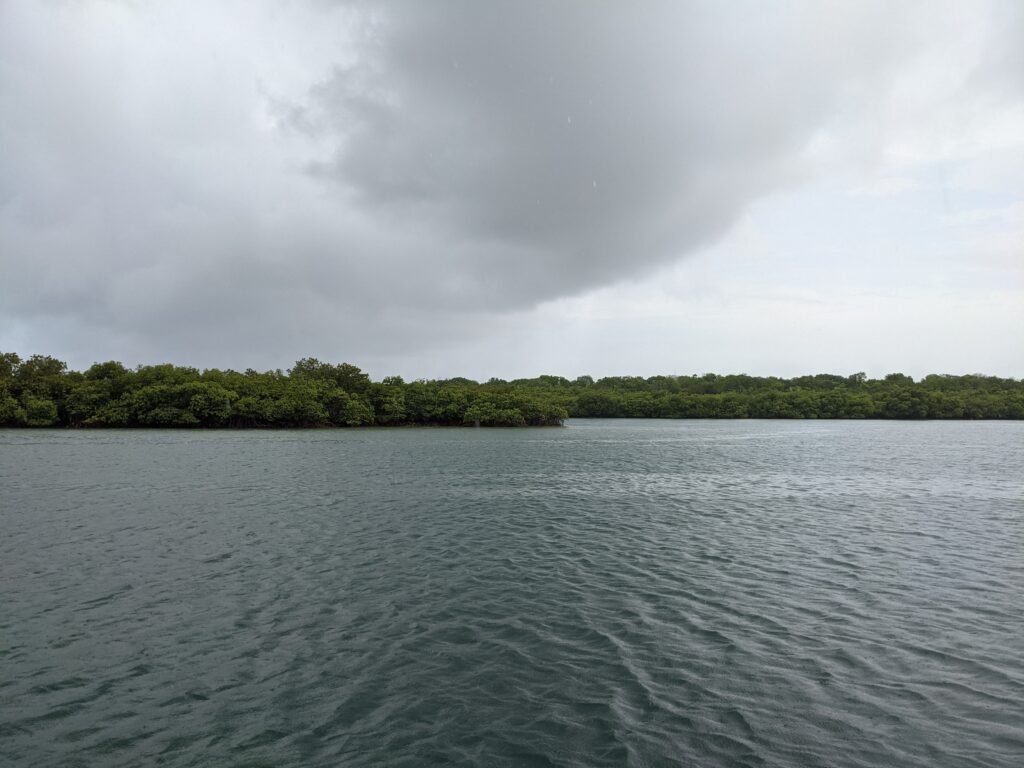
The national parks have always captivated me. How could they not? The inspirational views, the wildness, the vastness — they never fail to mesmerize. Beyond their charismatic looks, the parks represent something special to the American people and the rest of the world. Their establishment and continued protection stem from the embodiment of an idea — the idea that our country, especially its natural, historical, and cultural resources, belongs to each and every one of us. The national parks and monuments exist because American citizens before us believed in the unlimited value of natural places and were committed to preserving them “for the enjoyment, education, and inspiration of this and future generations” (National Park Service, 2021).
To fulfill the mission of the National Park Service (NPS) requires an incomprehensible amount of organization, communication, collaboration, and plain ol’ get-your-hands-dirty work. As necessary as it is for me to shed light on the underwater research being conducted throughout the parks, I believe it’s equally important to acknowledge the countless individuals who serve as stewards for the NPS, working day in and day out to care for the resources on NPS lands and educate others about their significance. For every day of my internship, I’ve been lucky to work with NPS employees and collaborators who carry this responsibility with grace, assiduity, and enthusiasm. They are driven beyond belief and true motivators. As I start another week of my internship, my motivation and enthusiasm for serving the greater mission of the NPS only grow.
—
Now that the women’s Wounded Veterans In Parks (WVIP) project has ended, I’m heading back to Homestead, FL with Annie and Susanna. We’re continuing work in Biscayne National Park, but this week Annie and Susanna will shift back to SRC archeological projects, and I’ll jump in with the park’s natural resources team. After a fairly easy drive, free from too much Florida Keys traffic, we arrive at our Airbnb. The rest of the SRC team is here, and two archeologists from the NPS’s Southeast Archeological Center (SEAC). I’m eager to spend a week with this crew, as I’ve only talked to most of the SRC folks in passing at the Denver office.
To everyone’s delight, the next day is a day off for the entire team. I’m certainly looking forward to buckling down with my laptop and getting caught up on a long list of logistical and administrative to-do’s. Before I get too sucked into my list, Brett offers to talk through his preferred workflow for importing, organizing, and editing photos in Adobe Lightroom (Adobe’s complex photo editing program). I’ve been hoping for this! I quickly accept. Lightroom overwhelms me, and the idea of weeding through 400 photos from last week’s WVIP project seems especially daunting (turns out, 400 photos are nothing for a weeklong project).
Brett and I sit at the computer desk with my SD card from last week’s project and jump into the nitty-gritty. Susanna sneaks in as well and joins the conversation. In the span of three hours, the SRC photography power duo gives me a comprehensive lesson on how to organize photo libraries, edit images, and most importantly, how to tell stories in an underwater environment. Brett points out certain things about the composition, framing, and lighting of my photos that could turn an okay shot into an eye-catching, compelling image. I try to play it cool as he and Susanna compliment some of my photos in the mix. Knowing what they’re capable of as photographers, it means a lot to hear their words of encouragement. In the end, Susanna suggests that they ship out a complete rig from the Denver office for me to use — a Nikon D800 with Aquatica housing and Ikelite strobes. I’m elated! They’re trusting me with a very expensive setup, and I’ll be able to take it to all of my upcoming destinations.
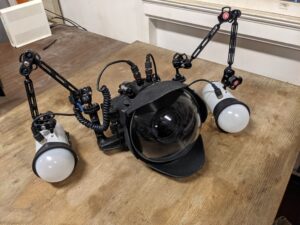
The Nikon D800 underwater setup. It’s a beast!
It’s an overwhelming experience, one I can’t really believe I’m living even as it’s happening. At the beginning of this internship, I expected writing to be my primary form of communicating underwater science to blog readers, friends, and family. Now, I’m learning an entirely new way to communicate science and ongoing research efforts. Little by little, Adobe Lightroom starts to seem more like a playground than a corn maze (albeit still confusing), and I find myself imagining shots that I hope to capture one day.
—
After the day off, it’s back to early morning starts and busy dive days. The entire crew empties out of the house and carpools to Biscayne NP. Verdant palm fields and stagnant canals stretch alongside the flat, stick-straight road as we drive into the park. The land-based section of Biscayne is fairly small, so I quickly run into the natural resources team. For the next two days, I’ll be assisting Morgan Wagner and Jade Reinhart with Reef Visual Census (RVC) surveys (the same type of surveys I did in St. Croix). Morgan is a biological science technician and Jade is a University of Miami student working as a park research assistant. We get to know each other as we load up the boat, a 27-ft. Boston Whaler, with an assortment of gear: a lionfish canister and spears (just in case we encounter the invasive species on our dives), marine debris bags, clipboards and datasheets, and a camera to take photos at each survey site.
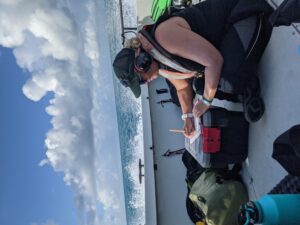
Morgan preps datasheets on the way to a survey site
A brief refresher on the RVC surveys: these surveys provide information on fish biodiversity, coral coverage, and reef distribution. We’ll be focusing solely on fish assessments this week, which includes recording all of the fish species we observe at a given site, along with their sizes and total abundance. After we load the boat, Morgan, Jade, and I don our personal flotation devices (PFDs) and headphones and jet to our first site. It’s a humid, sunny day, and I nearly give myself whiplash looking around at all of the different keys and mangroves scattered throughout the water. Morgan points out Adams Key, which used to be home to the old Cocolobo Club, a destination for a handful of presidents and many of the rich and politically connected. She continues the history lesson along the way. “That rock over there? Pirates used to tie their sails down behind it, which tilted the boat so others couldn’t see it. Then they’d jump out and ambush other boaters.” Thankfully, we make it to our sites pirate-free.
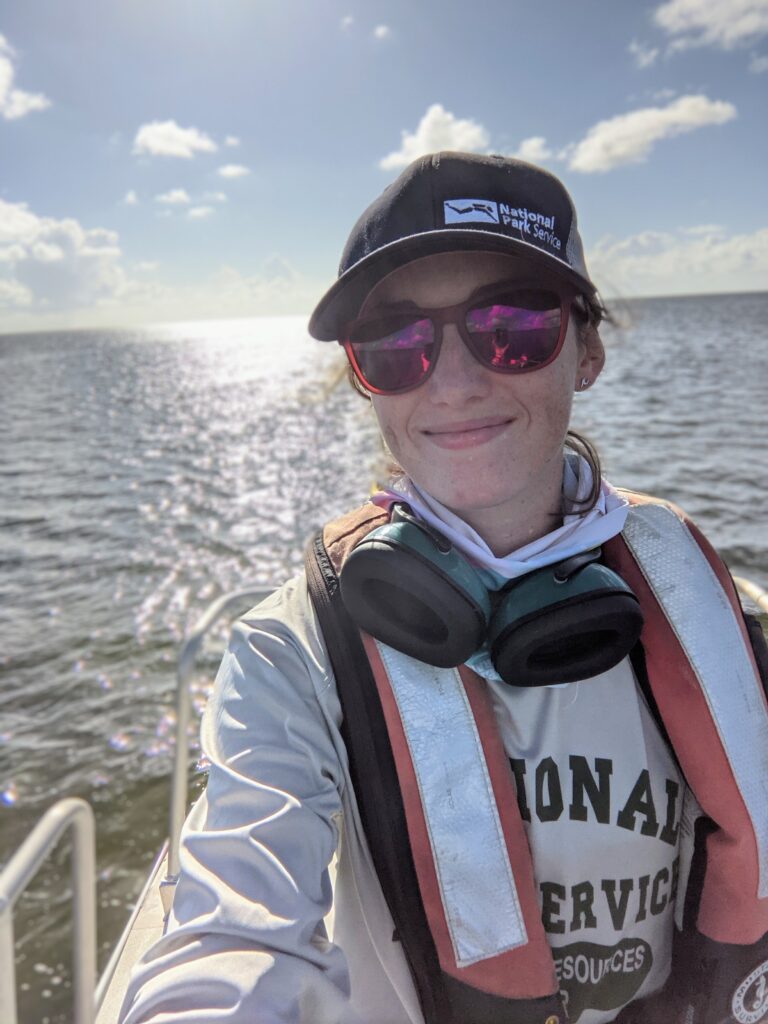
Necessary gear for being out on the water all day: Hat, sunglasses, sunscreen, and a PFD. The headphones are a nice way to muffle the wind and engine noise while we’re in transit.
Not every site is exciting. Sometimes they’re dominated by seagrass, or they’re mostly sandbeds with a few lonely corals and rocks. But, occasionally there’s a surprise. We drop down on the third site for the day and I kneel in the sand, recording a few small gobies and damselfish I see in front of me. Then, there’s a sudden movement in the corner of my eye. I glance up, only to be nearly smacked in the face by the caudal fin of a lemon shark! The shark swiftly disappears into the distance, and I’m left wide-eyed and laughing at the scare. It’s a fun element of being underwater. You never know what might emerge from the blue!
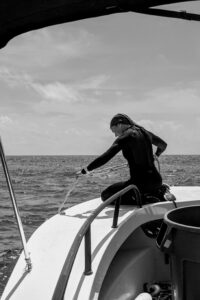
Jade fixes the boat’s anchor line with a new knot.
Storms move in during the afternoon, so we find ourselves dodging lightning and storm clouds as we make our way back to the park. Once we return, another surprise! While we were out doing RVC surveys, the SRC and SEAC crews were on their own boats, one of which is for anomaly jumping. High-resolution magnetic surveys are conducted throughout the park’s waters to identify anomalies — areas with the presence of iron on the seafloor. The magnetometers used to conduct the surveys are incapable of discerning derelict traps or other garbage from potentially historical submerged shipwrecks, though. Therefore, the SRC archeologists dive at each anomaly site to determine whether it’s an area of historical significance or not. Most of the time it’s just a piece of garbage, but we find out once we dock our boat that the crew came across an airplane wreck today! Everyone is in great spirits as we unload the boats, rinse gear, and call it a day.
Morgan, Jade, and I have another successful day of RVC surveys, and the following day I am placed with another crew of park biotechs and interns. Gabrielle Cabral, Zoe Dallaert, Cate Gelston, and John Ricisak, a collaborator from the Miami Dade County Department of Regulatory and Economic Resources, are heading out to collect illegal lobster, spider crab, and stone crab traps in Biscayne Bay. There are seasons for trapping each of these crustaceans, but at this time of year, the remaining traps in the water are illegal. To find them, we scout from the boat and search the water’s surface for floating buoys. Once we spot one, we drive over and use a long hook to grab the buoy line and pull the trap out of the water. These traps are heavy — around 50 pounds — so it’s easier when two of us grab the slimy, algae-covered rope and hoist each trap up together. After pulling up the trap, we open it up and free any creatures who have been stuck, careful not to grab them in order to keep our fingers intact. John tells us that stone crabs can easily cut off a finger with their large claw.
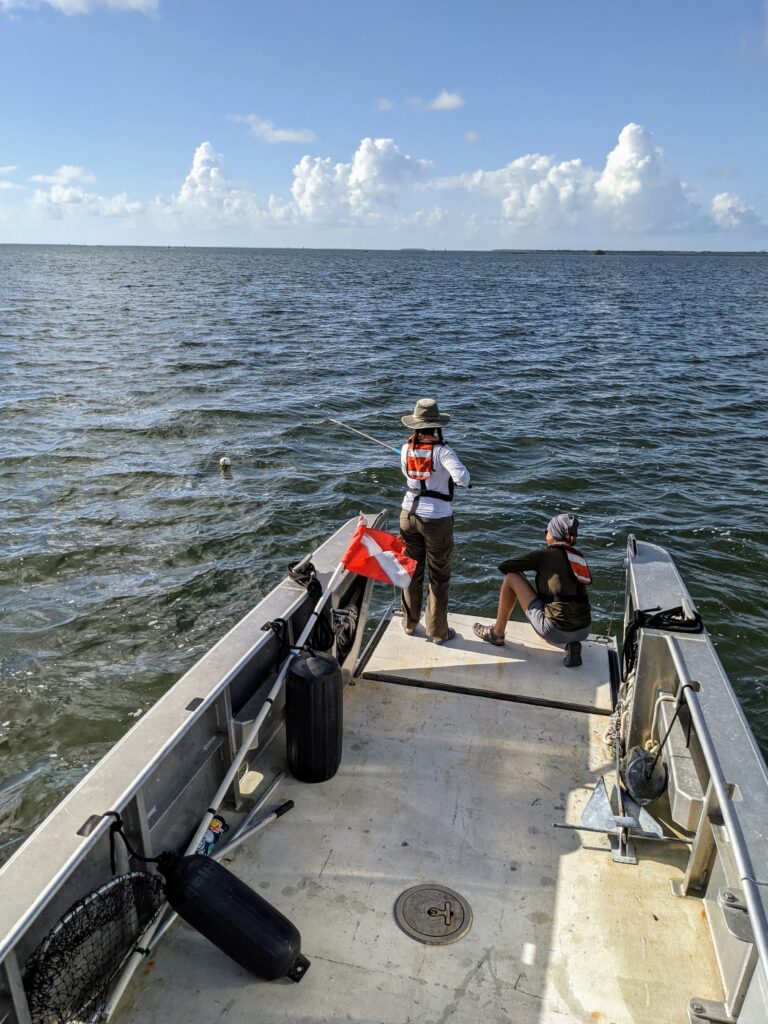
Gabby and Zoe prepare to hook the buoy line of a derelict lobster/crab trap.
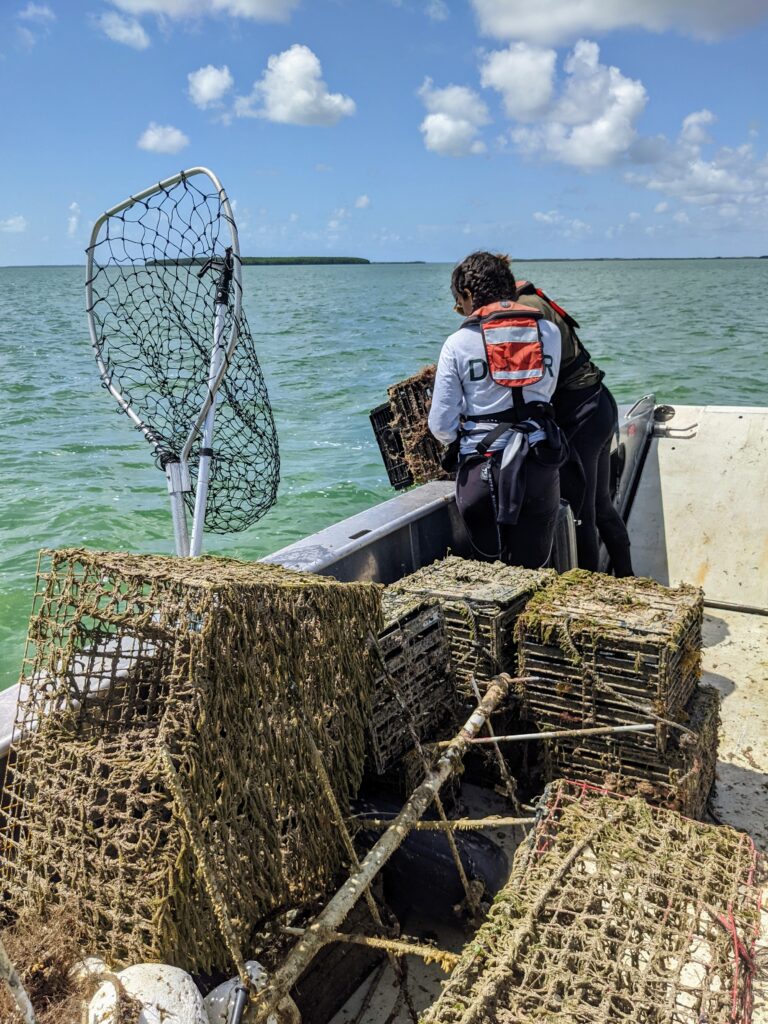
Pulling up a trap. We’ve already collected quite a few by mid-morning!
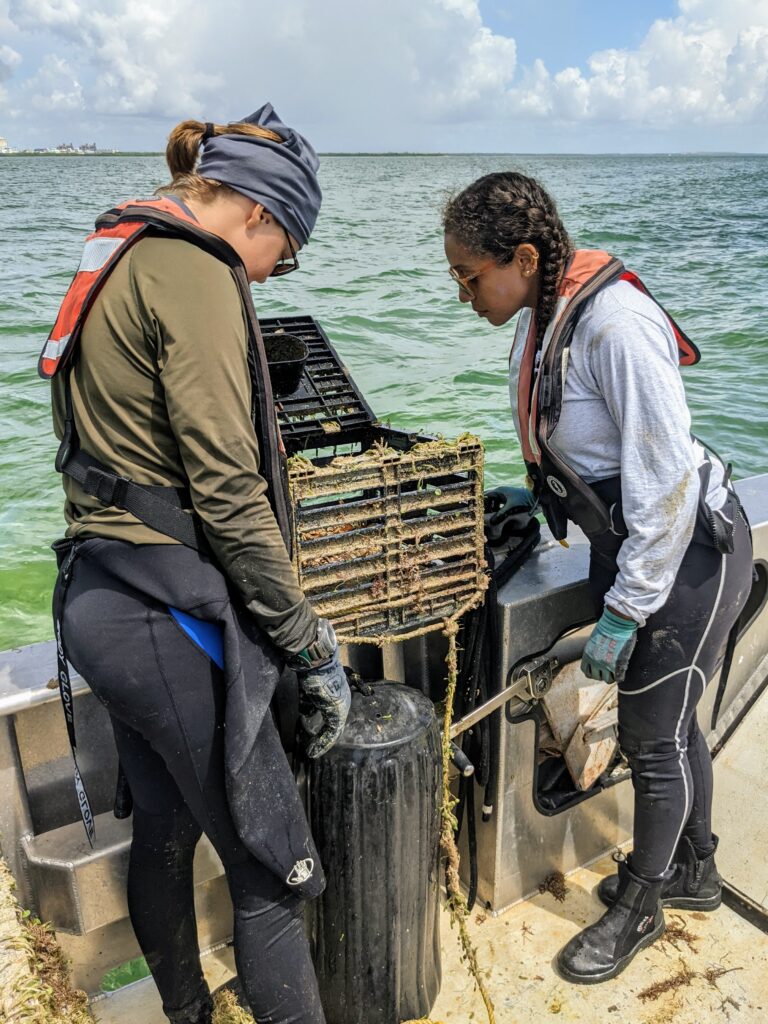
“What’s in this one?”
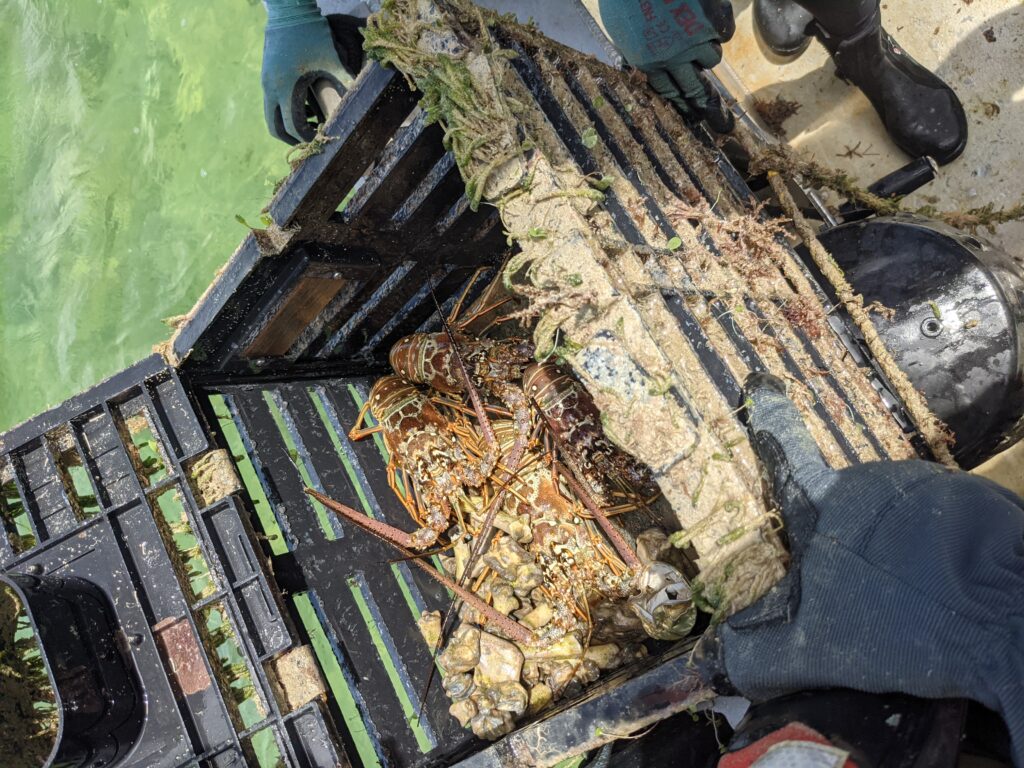
Lobsters and crabs wait to be freed back into Biscayne Bay
It’s a messy business, and we’re all quickly coated in green algae and murky brown slime from handling the traps. Regardless, it’s fulfilling work, and by the mid-afternoon there are towering piles of traps on the boat, making it nearly impossible to get to the bow. Offloading the boat takes a while with so many traps, and we then have to load them up into an NPS truck so they can be taken to the dump. The park just got a beautiful new truck, and the bed is literally spotless. Not for long, though! We manage to barely fit all of the traps from the day into the bed of the truck, and then spend quite a while rinsing down the truck to return it to its new, shiny condition. Park service equipment is put through a lot, but everyone tries their best to take good care of what they use.
—
All in all, this week is an exciting way to experience more of the Florida Keys, continue to explore Biscayne NP, and get to know the SRC crew. Although my fieldwork is separate from theirs, living together offers a unique opportunity to talk to everyone and to learn more about their jobs as underwater archeologists. Not only that, but I get to observe how their field crew operates together, something that I find particularly interesting as I jump into multiple crews throughout the park system. With field crews, everything suddenly becomes very close-knit, from conversations to physical spaces. In our case, the Airbnb is simultaneously operating as a gear locker, office space, and living space. The coffee table is covered in books about disappeared wrecks and reports of underwater historical and cultural resources. Gear bags and pelican cases take up an entire corner of the living room, and there are dive booties and miscellaneous gear drying on the patio furniture in the backyard. “Work” is always around, but people find ways to sit back at the end of the day and relax. AJ strums his guitar in the evenings on the back patio. David and I get wrapped up in conversations over coffee about travel, life, and his boisterous kids. In the evenings, Matt and Dave watch TV, switching between The Office and various movies. We go out for dinner a few nights, too, grabbing barbecue from a local joint in town and going out on another evening to celebrate Matt’s birthday. As eager as I am to head to my next destination, Dry Tortugas National Park, I’m going to miss hanging out with the SRC crew.
To everyone who made my week a success, thank you. Morgan, Jade, Gabrielle, Zoe, and Cate — thanks for letting me come along and showing me the Biscayne experience. You are all rockstars! A massive thank you to the entire SRC crew for truly making me feel like part of the team and for supporting my ambitions and hopes for this internship. Brett and Susanna, I cannot thank you enough for teaching me, encouraging me, and most of all, entrusting me with an SRC camera rig. I’m determined to break into the world of underwater photography now, and I couldn’t do it without the support from OWUSS and the SRC. I hope that I can hone my skills in the coming weeks and use them to share the beauty of the national parks and the scientific research and work being done within them.
References:
- National Park Service U.S. Department of the Interior. (June 2021). What We Do (U.S. National Park Service). https://www.nps.gov/aboutus/index.htm#:~:text=Follow%20Us-,Our%20Mission,of%20this%20and%20future%20generations.


Great photos Sarah! So fun to read about.